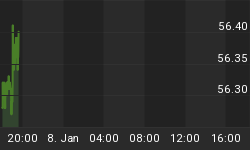I am often asked "when will we know that this time is different?" My answer is that we won't likely know until after the fact, but I can characterize what those words mean.
In essence, the "this time is different" scenario is often characterized by rising prices and excessive bullish sentiment. The market continues higher despite the extremes in bullish sentiment.
The Price Cycle
The price cycle is the path prices take throughout time. The normal pattern is for prices to move from low to high and back to low again where the cycle starts all over again. If we use sentiment to characterize the price cycle, sentiment goes from bearish (i.e., prices are low) to bullish (i.e., prices are high) and then back to bearish. The normal pattern for the price cycle looks like this:
low prices (bearish sentiment) => high prices (bullish sentiment) => low prices (bearish sentiment)
Every now and then the price cycle looks like this:
low prices (bearish sentiment) => high prices (bullish sentiment) => high prices (bullish sentiment)
In other words, the market doesn't correct back to lower prices and it just continues higher dragging bullish sentiment along for the ride.
So how do we characterize this? For starters, let's look at the "Dumb Money" indicator, which I show every week in our wrap up on market sentiment. This is in the middle panel. The indicator in the lower panel only shows those times when investors are extremely bullish (i.e., the "Dumb Money" indicator is red), and this would be when the indicator is up.
Figure 1. Dumb Money Indicator
Look at the gray vertical lines on the chart and focus on the lower panel. At point 1, sentiment was bullish to an extreme degree. Prices did not correct but consolidated over the next 2 months. At point 2, sentiment became neutral (or was no longer extremely bullish). At point 3, investors became extremely bullish again, and sentiment stayed bullish for many months (arrow) while prices ground higher. In essence, the price cycle did not follow the "normal" pattern of low to high and back to low but followed our variant or "this time is different" pattern.
So let's design a study where we trade the "this time is different pattern". We will use the NASDAQ 100 (symbol: $NDX.X), and our study goes back to 1992. Our entry signal is when extreme bullish sentiment does not correct to bearish sentiment but re-establishes itself following a period of neutral sentiment. Numbers 3, 4, and 5 on the chart above would be such signals. Our exit signal is when investor sentiment, as measured by the "Dumb Money" indicator is no longer at a bullish extreme.
Since 1992, there have been 16 occurrences (or trades), and 10 were profitable. This strategy generated 584 $NDX.X points; buy and hold $NDX.X generated 1900 points. However, with the strategy you were only exposed to market risk 10% of the time. So with this strategy you made one - third of a buy and hold strategy with one-tenth the market exposure. Equity curve draw down was about 25%, which is significantly less than buy and hold. The average trade duration was 42 trading days.
The equity curve for this strategy is shown in figure 2.
Figure 2. Equity Curve 
The maximum adverse excursion (MAE) graph is shown in figure 3. MAE looks at every trade from this strategy. MAE measures how much a trade moves against its original position before being closed out. It is the angst factor. Take the trade inside the blue box. This trade moved 4.15% adverse to its entry price (x axis) before being closed out for a 1.03% loss (y axis). We know this was a losing trade because it is a red caret. What we can infer from the MAE graph? If a trade has an MAE less than 3% (to the left of the blue line) it is likely that it will be a winning trade. There are several trades that had near 10% losses before recovering.
Figure 3. MAE Graph 
Now let's look at the maximum favorable excursion (MFE) graph. See figure 4. MFE measures how far a particular trade moves or runs up (x axis) in your favor before it is closed out. What we note is that the 4 trades labeled on the graph coincide with the most bullish runs of the past 15 years. Yes, it does take bulls to make a bull market.
Figure 4. MFE Graph
In summary, I have tried to characterize the "this time is different" scenario, and I believe I have captured this market dynamic of prices continuing higher despite the presence of too many bulls. Remember, the outcome of this scenario is never known beforehand, but if you don't play then there is no pay!
I have utilized the $NDX.X in this analysis; the S&P500 produces similar but not as stunning results, and this may be due to investors chasing performance at this stage of the price cycle in the more speculative type assets. In any case, with regards to the S&P500 at this point in time, overbought and overbullish plus strong price trends in gold, crude oil and Treasury yields equals high risk and strong headwinds for this index.
















